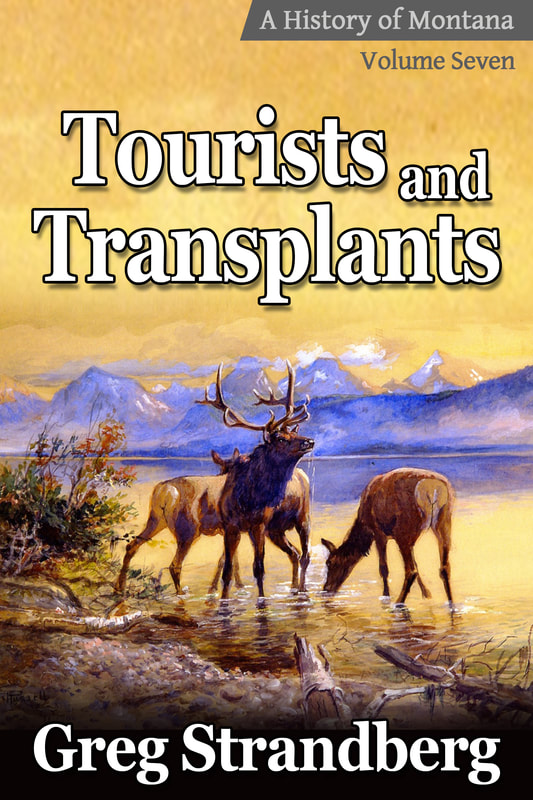 Ralph DeCamp painting
Ralph DeCamp painting
Montana has a long tradition of progressive politics, and it really got started in the late-1890s and early-1900s.
The terrible business climate that favored the rich, and the media-drummed-up war with Spain, had people saying to hell with politics as usual. Voters abandoned the Republicans and Democrats in droves as populism rose up.
Populism and progressive political ideals found fertile ground in Montana during the 1890s. The death knell of silver with the Fourth Coinage Act of 1873 had spurred many people that might not otherwise have been politically active to seek redress for their grievances.
Although largely made up of farmers in other states, Populism took hold in Montana with disenchanted miners and other workers that felt the rich were getting too much in the way of handouts and government representation.
It’s also important to note that Republicans were the progressive, anti-corporate party of America at that time.
The true enemies of the people – the rich men – were all Democrats, or at least a distorted form of them. James J. Hill is a good example.
He never much got interested in politics, but he most definitely didn’t like a lot of the progressive ideals, or anti-business sentiment, that seemed to exist.
He would have been considered a Bourbon Democrat, which was a term thrown around from 1876 to 1904 to describe those with laissez-faire attitudes and opposition to protectionism that characterized a lot of the Republican stances during that time.
For them, expanding the business interests of the United States was the most important thing, issues like overseas imperialism and free silver not so much.
Many businessmen like Hill held these views, and they felt that a level playing field for business was best, which required the government to be both free of corruption and unjust regulations such as those that would eventually go against monopolies.
Most Democrats did not like that idea too much, as they wanted to help businesses make as much money as possible. This typically helped them line their own pockets.
So the populists rose up and then the progressives after them. Republicans saw this and latched onto it, or more appropriately, progressives saw the Republican Party as their best bet to get elected in a two-party system and subverted it.
This was especially true when Roosevelt came to office at the death of McKinley.
Suddenly that dead-end VP job Roosevelt had been handed didn’t seem so dead-end. He became the 26th President of the United States and immediately set forth on a populist, progressive and reformist national agenda while at the same time doing his all to build up America’s reputation abroad.
In Montana that meant sweeping changes in how things were done, changes that would have long-lasting effects that are still being felt today.
It lasted a few years, then the Bull Moose Party came and with them Woodrow in the White House. It was clear as early as the 1910s that progressivism simply would not take hold as its own party.
Jeanette Ranking knew this. Her interest in politics was piqued in 1914 when her younger brother, Wellington Rankin, ran for the U.S. House of Representatives on the Progressive ticket. Unfortunately, he lost, but she learned the GOP would serve her progressive ideas better and she ran on that ticket in 1916 and won.
The Republican Party had been subverted by progressives but the party elders were smart enough to absorb those changes while still serving as a counterweight to the pro-business Democrats.
There were spits in the Democratic Party as well, and Montana politicians capitalized on that to gain wider influence nationally and broader appeal at home.
In 1924, just two years after being elected, Montana’s Senator Burton Wheeler split with the Democratic Party to join Robert M. La Follette when he ran on the Progressive Party ticket in the presidential election that year.
They lost spectacularly and the pro-business climate of the Democrats continued in Washington, with Republicans going that route more and more as well.
“The Progressives had come, they fought, they had almost always lost – and then they went,” Montana historian K. Ross Toole said of Montana in the 1930s and 1940s. “Montana was in for a long sleep.”
People still tried. Miles Romney ran for governor on the Progressive Democrat ticket in 1932, lost badly as well.
Roosevelt’s New Deal brought the progressive agenda back to the fore, at least nationally. FDR - boy did he abandon his class, and turn his back on business as usual when it came to the pro-business Democrats.
The Temporary National Economic Committee, or TNEC, started in 1938. It was a clear sign that the more progressive wing of FDR supporters had triumphed over the more business-minded. The Committee’s task was investigating the “concentration of economic power in twentieth-century America.”
There were still a lot of progressive farmer-labor groups in Montana, and there was still a lot of distrust over business. Distrust over government grew stronger in the late-30s as well.
After the split over FDR’s court packing and all the heated words in 1937-8, the “left wing of the Democratic party rose up in open rebellion,” Malone writes.
The Montana Council for Progressive Political Action was created in 1938 and it meant business. Full of American Federation of Labor members, people from the Congress of Industrial Organizations, farmers from the Farmers Union, and more unemployed than they’d probably care to admit, the Council had a growing level of influence and a high level of frustration.
By 1939 – the year they started up the People’s Voice, a reform newspaper that would run for three decades – the Council for Progressive Political Action was ready to do battle, ensuring its voice was heard.
If that meant Democrats suffered in the face of third-party candidates, so be it. “Once again, as on the eve of World War I,” Malone writes, “there was thunder on the left in Montana.”
A large part of the problem with the 1940 election from the Democrat’s perspective was their inability to marshal the forces of the left. The Council for Progressive Political Action attacked the more conservative Democrats and this may have cost Roy Ayers the governor’s chair.
Senator Burton Wheeler was too entrenched to lose out, and appealed enough to conservatives to win over a large portion of the Republican vote, and the mainstay – and current powerbase – of the Democratic Party. Historian Michael P. Malone explains this:
“The New Deal had restored the power of the liberal community in Montana, and it closed in 1938 with an incredible scrambling of party lines. Liberal and conservative Democrats parted company, and the Republicans were able to regain power by joining hands with the conservative Democrats.”
Since both Senator Wheeler and Wellington Rankin had come up during the more progressive 1910s, however, they tended to see eye to eye on issues. What’s more, with Wheeler’s national split from FDR and continual battling with various factions of the Montana Democratic Party, he needed all the friends he could get. One of those friends was Sam Ford.
Ford was a “veteran of the old progressive wing of the Republican party,” Malone tells us. In 1940, Ford decided to run for governor, and those old progressive ideals no doubt helped him better understand the electorate.
It’s always been shaky ground in Montana, and conservatives, liberals, and progressives often have to enter into some kind of power-sharing deal.
The years rolled on. Mansfield rose to the fore in Washington, with the help of JFK’s decisions. Both were Irish Catholics and both were “progressive Democrats with a similar political outlook.”
By the 1970s “Montana’s political progressives – still Democrats – are now to be found almost exclusively among deep thinkers in urban areas of the western half of the state,” historian David Emmons tells us.
“The Constitution of 1972, for example, passed despite the fact that forty-four counties voted against it. Of the twelve counties that supported it, all were urban and nine were in the western district.”
The earlier progressive tradition of Republican politics that Montana had seen in the 1910s and 1920s was long gone by the Reagan years. Republicans nationally and in Montana were once again pro-business and didn’t much care about common people and ordinary workers.
Democrats had had a few good years in the 1970s, with Governor Judge and his progressive ideas. In fact, Montana saw so much environmental legislation come out of Helena and Washington that the pro-business forces were dealt decades-long setbacks.
They came roaring back in the 1980s, hamstringing a passive Governor Schwinden in the legislature before installing Stan Stephens in the governor’s chair in the late-80s, then Marc Racicot for the rest of the 90s. A single term of Judy Martz in the early-2000s left Montana with nearly 20 years of pro-business policies and mishaps to clean up.
Clean up they’d be hard to do, as those pro-business forces controlled the legislature, often veiling their agenda in a quasi-populist message to further hoodwink the farmers and ranchers that’d been bought and paid for by federal subsidies decades earlier.
It was a sad time in Montana, and to counter it the Democrats chose to go the same route of pro-business sentiment as opposed to revisiting their progressive roots.
But it was never the Democrats that were progressive, it was always the Republicans. As the 2010s came along many of Montana’s moderate Republicans could probably qualify as progressive, though their party keeps a tight hold of them lest these ideas spread to the hardliners whose money calls the shots.
That’s the situation as I see it in Montana and we’ll look at our current crop of candidates through a progressive lens later in the day.

